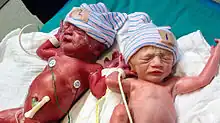| Twin anemia-polycythemia sequence | |
|---|---|
 | |
| Twin anemia-polycythemia sequence is a monochorionic twin condition characterized by a large intertwin hemoglobin difference. | |
| Specialty | Obstetrics |
Twin anemia-polycythemia sequence (TAPS) is a form of chronic inter-twin transfusion.[1][2][3][4][5][6][7][8][9][10][11] It is distinguished from classic twin-to-twin transfusion syndrome by differing red blood cell counts between the fetuses, a relative lack of symptoms and a lack of oligohydramnios or polyhydramnios among the fetuses.[12]
Monochorionic twin pregnancy complication
Diagnosis and staging

Different stages of TAPS are identified using the criteria as shown in the following tables.[4]
Postnatal classification
| Postnatal stage | Intertwin hemoglobin difference (g/dL) |
|---|---|
| Stage 1 | >8.0 g/dL |
| Stage 2 | >11.0 g/dL |
| Stage 3 | >14.0 g/dL |
| Stage 4 | >17.0 g/dL |
| Stage 5 | >20.0 g/dL |
Treatment
The use of the so-called Solomon technique or dichorionization in fetoscopic laser therapy for twin-to-twin transfusion syndrome is proven to be beneficial in preventing post-laser TAPS.[14] With this technique, not only all anastomoses are coagulated (closed) but also a line is drawn between those in order to coagulate anastomoses that might not (yet) be visible during fetoscopy. It should be stressed that the success of such a technique is highly dependent on the specific situation. For example, when one of the fetuses obstructs the view on the vascular equator (the part of the placenta where the anastomoses need to be coagulated), complete dichorionization by the Solomon technique might not be possible.
Perinatal outcome
See also
References
- 1 2 Lopriore, E.; Middeldorp, J.M.; Oepkes, D.; Kanhai, H.H.; Walther, F.J.; Vandenbussche, F.P.H.A. (2007). "Twin Anemia–Polycythemia Sequence in Two Monochorionic Twin Pairs Without Oligo-Polyhydramnios Sequence". Placenta. 28 (1): 47–51. doi:10.1016/j.placenta.2006.01.010. PMID 16516289.
- 1 2 Lopriore, E; Deprest, J; Slaghekke, F; Oepkes, D; Middeldorp, J M.; Vandenbussche, F P. H. A.; Lewi, L (2008). "Placental Characteristics in Monochorionic Twins With and Without Twin Anemia–Polycythemia Sequence". Obstetrics & Gynecology. 112 (4): 753–758. doi:10.1097/aog.0b013e318187e1ff. PMID 18827116. S2CID 33703154.
- 1 2 Lewi, Liesbeth; Jani, Jacques; Blickstein, Isaac; Huber, Agnes; Gucciardo, Leonardo; Mieghem, Tim Van; Doné, Elisa; Boes, Anne-Sophie; Hecher, Kurt (2008). "The outcome of monochorionic diamniotic twin gestations in the era of invasive fetal therapy: a prospective cohort study". American Journal of Obstetrics and Gynecology. 199 (5): 514.e1–514.e8. doi:10.1016/j.ajog.2008.03.050. PMID 18533114.
- 1 2 3 4 5 Slaghekke, F.; Kist, W.J.; Oepkes, D.; Pasman, S.A.; Middeldorp, J.M.; Klumper, F.J.; Walther, F.J.; Vandenbussche, F.P.H.A.; Lopriore, E. (2010). "Twin Anemia-Polycythemia Sequence: Diagnostic Criteria, Classification, Perinatal Management and Outcome". Fetal Diagnosis and Therapy. 27 (4): 181–190. doi:10.1159/000304512. PMID 20339296.
- 1 2 Robyr, Romaine; Lewi, Liesbeth; Salomon, Laurent J.; Yamamoto, Masami; Bernard, Jean-Pierre; Deprest, Jan; Ville, Yves (2006). "Prevalence and management of late fetal complications following successful selective laser coagulation of chorionic plate anastomoses in twin-to-twin transfusion syndrome". American Journal of Obstetrics and Gynecology. 194 (3): 796–803. doi:10.1016/j.ajog.2005.08.069. PMID 16522415.
- 1 2 Habli, Mounira; Bombrys, Annette; Lewis, David; Lim, Foong-Yen; Polzin, William; Maxwell, Rose; Crombleholme, Timothy (2009). "Incidence of complications in twin-twin transfusion syndrome after selective fetoscopic laser photocoagulation: a single-center experience". American Journal of Obstetrics and Gynecology. 201 (4): 417.e1–417.e7. doi:10.1016/j.ajog.2009.07.046. PMID 19788973.
- 1 2 Lopriore, E.; Hecher, K.; Vandenbussche, F.P.H.A.; Wijngaard, J.P.H.M. van den; Klumper, F.J.; Oepkes, D. (2008). "Fetoscopic laser treatment of twin-to-twin transfusion syndrome followed by severe twin anemia-polycythemia sequence with spontaneous resolution". American Journal of Obstetrics and Gynecology. 198 (2): e4–e7. doi:10.1016/j.ajog.2007.08.073. PMID 18226611.
- 1 2 Herway, C.; Johnson, A.; Moise, K.; Moise, K. J. (2009-05-01). "Fetal intraperitoneal transfusion for iatrogenic twin anemia–polycythemia sequence after laser therapy". Ultrasound in Obstetrics and Gynecology. 33 (5): 592–594. doi:10.1002/uog.6334. ISSN 1469-0705. PMID 19402103.
- 1 2 Lopriore, E.; Wijngaard, J.P.H.M. van den; Middeldorp, J.M.; Oepkes, D.; Walther, F.J.; Gemert, M.J. van; Vandenbussche, F.P.H.A. (2007). "Assessment of Feto-fetal Transfusion Flow Through Placental Arterio-venous Anastomoses in a Unique Case of Twin-to-Twin Transfusion Syndrome". Placenta. 28 (2–3): 209–211. doi:10.1016/j.placenta.2006.03.006. PMID 16678896.
- 1 2 Weingertner, A. S.; Kohler, A.; Kohler, M.; Bouffet, N.; Hunsinger, M. C.; Mager, C.; Hornecker, F.; Neumann, M.; Schmerber, E. (2010-04-01). "Clinical and placental characteristics in four new cases of twin anemia–polycythemia sequence". Ultrasound in Obstetrics and Gynecology. 35 (4): 490–494. doi:10.1002/uog.7508. ISSN 1469-0705. PMID 20069657.
- ↑ "Home". tapssupport.com.
- ↑ "Twin Anemia Polycythemia Sequence". NORD (National Organization for Rare Disorders). Retrieved 2021-10-04.
- ↑ Genova, L.; Slaghekke, F.; Klumper, F.J.; Middeldorp, J.M.; Steggerda, S.J.; Oepkes, D.; Lopriore, E. (2013). "Management of Twin Anemia-Polycythemia Sequence Using Intrauterine Blood Transfusion for the Donor and Partial Exchange Transfusion for the Recipient". Fetal Diagnosis and Therapy. 34 (2): 121–126. doi:10.1159/000346413. PMID 23713060. S2CID 28413969.
- ↑ Bamberg, C.; Hecher, K. (2019). "Update on twin-to-twin transfusion syndrome". Best Practice & Research Clinical Obstetrics & Gynaecology. 58: 55–65. doi:10.1016/j.bpobgyn.2018.12.011. PMID 30850326. S2CID 73503459.
- ↑ Lopriore, E.; Slaghekke, F.; Kersbergen, K. J.; de Vries, L. S.; Drogtrop, A. P.; Middeldorp, J. M.; Oepkes, D.; Benders, M. J. (2013-06-01). "Severe cerebral injury in a recipient with twin anemia–polycythemia sequence". Ultrasound in Obstetrics & Gynecology. 41 (6): 702–706. doi:10.1002/uog.12337. ISSN 1469-0705. PMID 23124777.
- ↑ Luminoso, D.; Figueira, C. O.; Marins, M.; Peralta, C. F. A. (2013-12-01). "Fetal brain lesion associated with spontaneous twin anemia–polycythemia sequence". Ultrasound in Obstetrics & Gynecology. 42 (6): 721–722. doi:10.1002/uog.12574. ISSN 1469-0705. PMID 23897836.
External links
- International Clinical Trial for best treatment for TAPS
- TAPS Support- Patient run advocacy website
- The TTTS Foundation